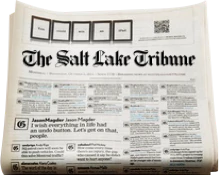This is an archived article that was published on sltrib.com in 2011, and information in the article may be outdated. It is provided only for personal research purposes and may not be reprinted.
The West is known for having a rich quality of life — offering settings for outdoor recreating such as hiking, biking, rafting and mountain climbing. The lifestyle that our region offers has kept many families living in the region for generations, and it is also what is drawing residents and businesses from the rest of the country to relocate here.
Yet the West is also home to rich oil and gas deposits, and over the past decade, development of these resources has led to a drilling boom. Unfortunately, as more wells are drilled and more oil and gas are pulled from the ground, the impacts grow, including those to air quality and the health of our population.
One need only scan headlines to recognize the severity of the problem. This year, for the first time ever, health officials issued a high-ozone alert in rural Rio Blanco County in northwestern Colorado, where emissions from oil and gas wells are cooked by the sun into hazardous pollution.
In rural Pinedale, Wyo., thousands of gas wells have left the town and surrounding ranches choking on smog levels that are higher than those in Los Angeles. Residents have complained to officials about a litany of health problems, from coughing and wheezing to shortness of breath.
And late in 2010 in eastern Utah's Uintah Basin, dense oil and gas drilling projects led to ozone levels in violation of federal health standards.
Despite their rural nature, the industrial-scale development of drilling activity in these places has turned air quality so poor that public health officials have urged elderly residents, children and people living with lung disease to stay indoors. It's forced day-care centers to keep kids inside at playtime.
Air pollution impacts are more commonly known to take their toll on metro areas. In Colorado, the Denver metro area is struggling with air quality issues that can be linked to drilling operations not too far away, as well as other sources such as power plant pollution and vehicle emissions.
Air pollution exacts a high toll on public health and our economy.
Respiratory illnesses such as asthma, emphysema and other lung diseases are all exacerbated by ozone pollution. Ground-level ozone, or smog, has been associated with increased emergency room visits, asthma attacks, missed days of work and school and mortality, all of which result in higher health care costs and increased insurance premiums.
To preserve the lung health of our residents, we must find a better way to balance energy needs with the economic necessity of clean air. If we want to maintain our one-of-a-kind quality of life, we need to better manage how we drill for oil and gas.
The individual oil and gas companies that have voluntarily begun to address air pollution are to be commended, but their efforts will only go so far. Protecting public health and welfare and safeguarding our air and land should not be left to chance. They should be guaranteed through better planning and management policies as well as enforceable drilling safeguards on public lands.
Interior Department Secretary Ken Salazar is working to foster more protective energy development on public lands through "Master Leasing Plans," which will take a more inclusive look at the cumulative impacts of drilling and determine how we can better mitigate air pollution impacts. We support this approach and we believe it can make a difference.
When you can't breathe, nothing else matters.
Don Hooper is the interim executive director of the American Lung Association in Utah. Curt Huber is the executive director of the American Lung Association in Colorado.

